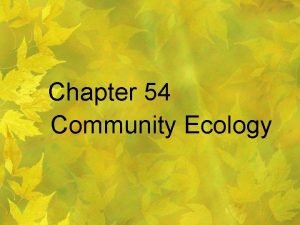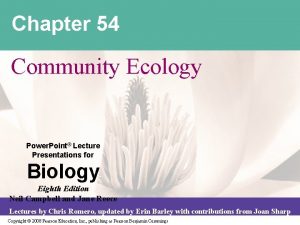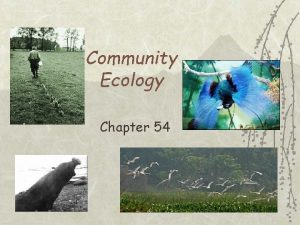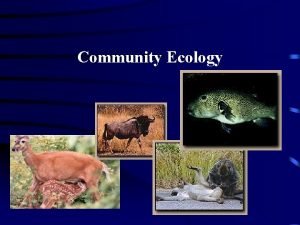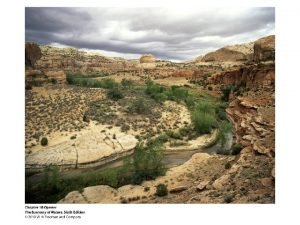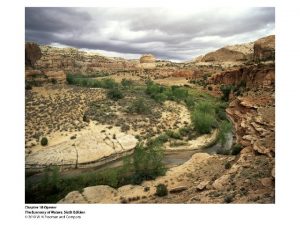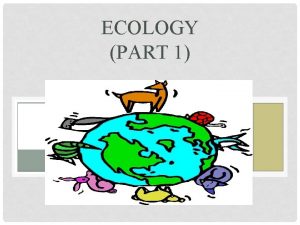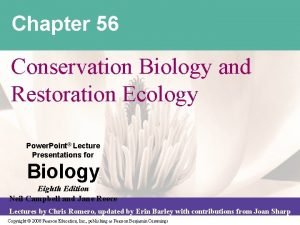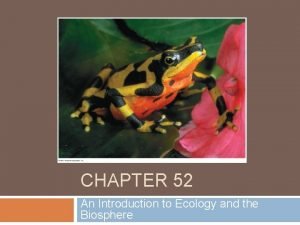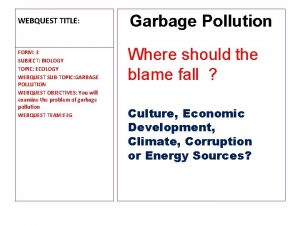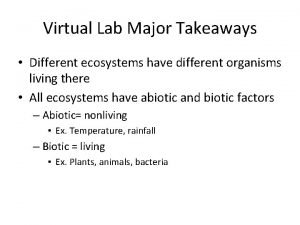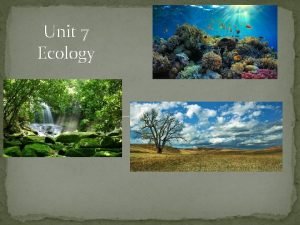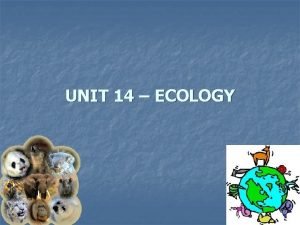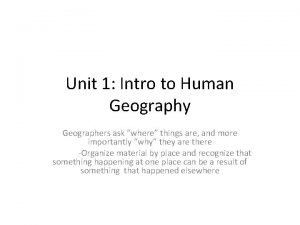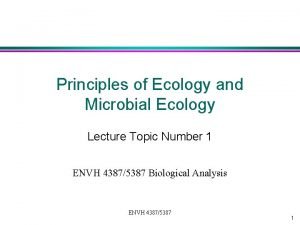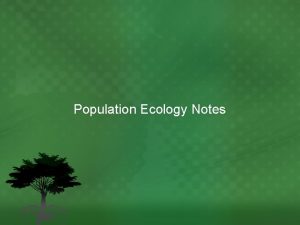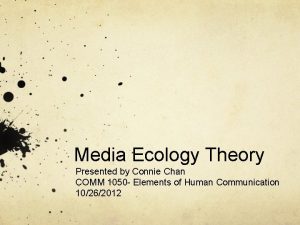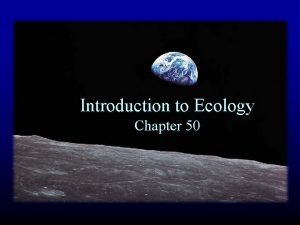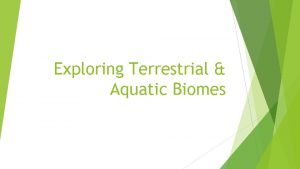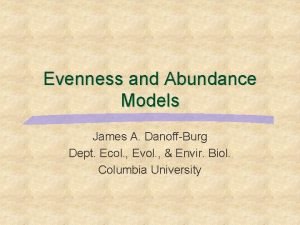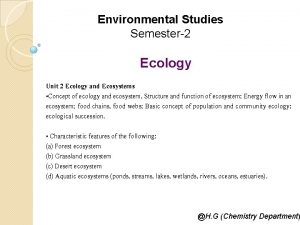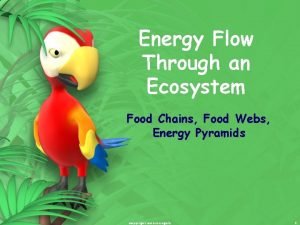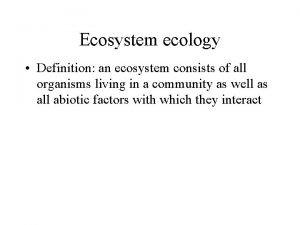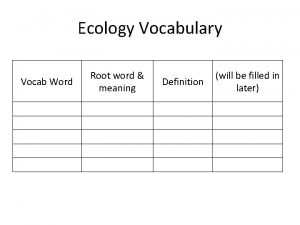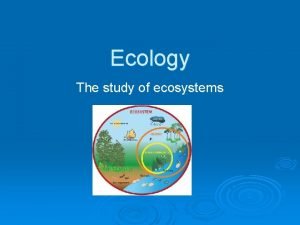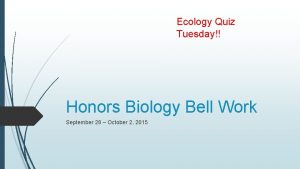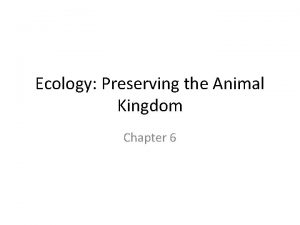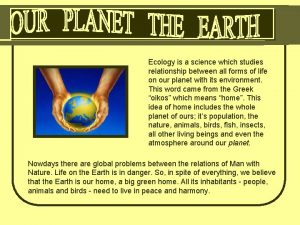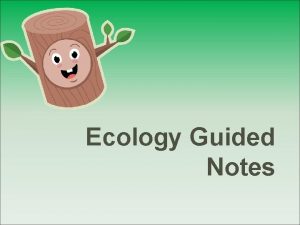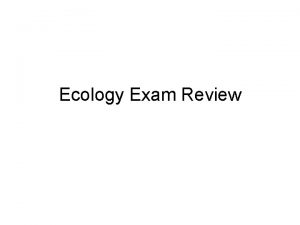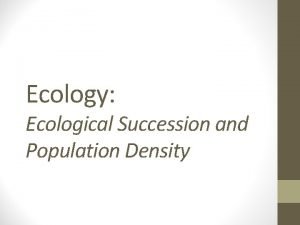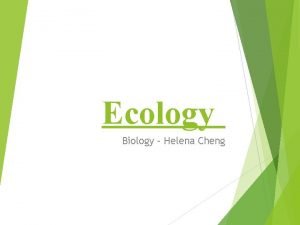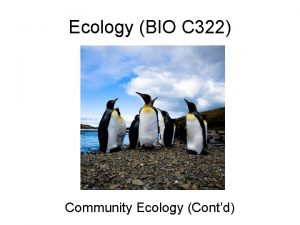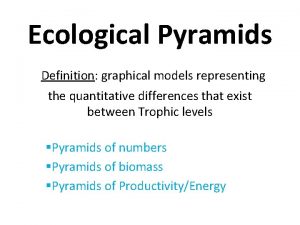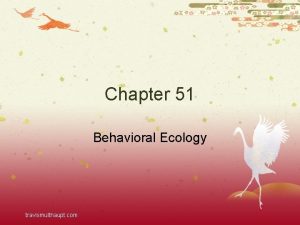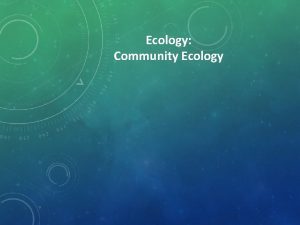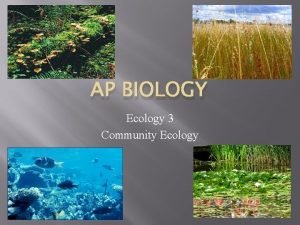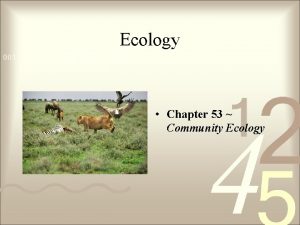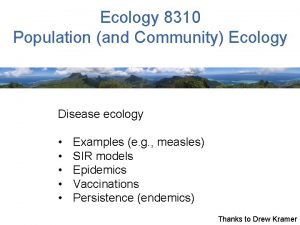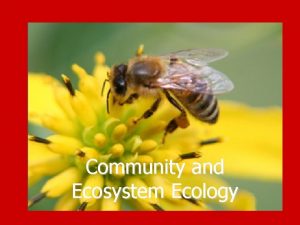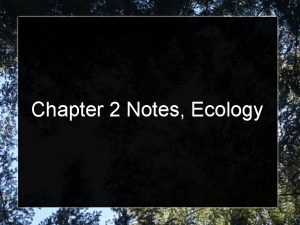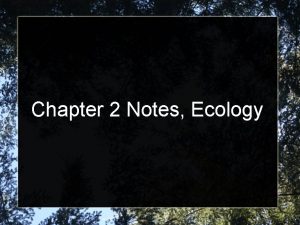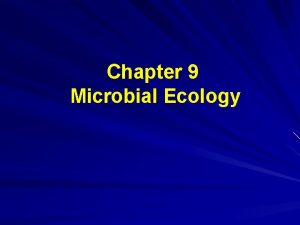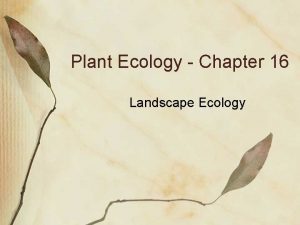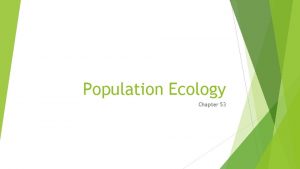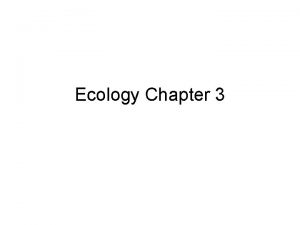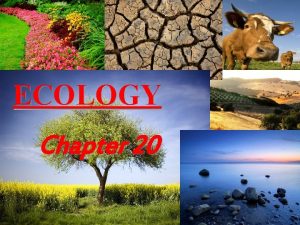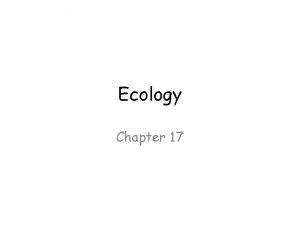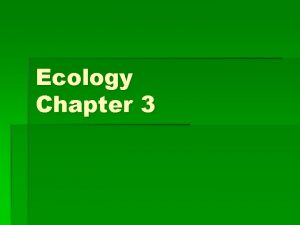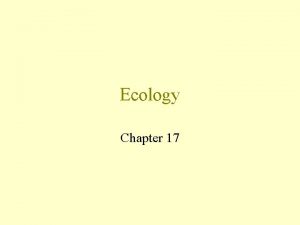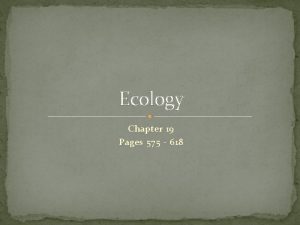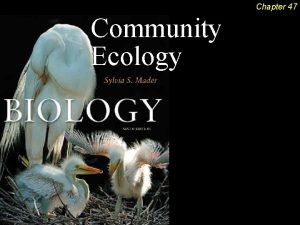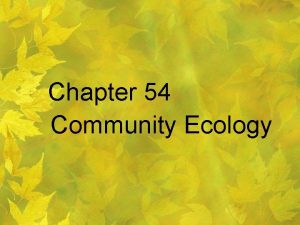Chapter 53 Community Ecology travismulthaupt com A Community






































































- Slides: 70

Chapter 53 Community Ecology travismulthaupt. com

A Community A community is all of the species within a given area that have the ability to interact with one another and their environment. Community structure is chiefly governed by the interactions of the organisms and their environments. travismulthaupt. com

Interspecific Interactions Interspecific interactions are the relationships in the life cycles of the organisms and their interactions with other species in the community. travismulthaupt. com

Possible Linking Interactions: 1. 2. 3. 4. Competition Predation Herbivory Symbiosis • Parasitism, • Mutualism, • Commensalism travismulthaupt. com

Interspecific Competition Occurs when species compete for a particular resource that is limited in some way. When both organisms compete for it, it may be detrimental to one or both organisms and may lead to competitive exclusion. travismulthaupt. com

Competitive Exclusion Occurs when one organism has a means to use a resource better than another. Thus, it is better able to reproduce and ultimately leads to the elimination of the other organism. travismulthaupt. com

G. F. Gause Arrived at the Principle of Competitive Exclusion while studying 2 species of paramecium. Each would grow well on their own-reaching a carrying capacity. When grown together, one would drive the other to extinction. travismulthaupt. com

Niche This is a species role in the environment --where and how it fits into an ecosystem. A species ecological niche is the sum total of all biotic and abiotic resources available to an organism within an environment. travismulthaupt. com

Niche In terms of the Competitive Exclusion Principle, two species cannot coexist in an ecosystem if their niches are identical. travismulthaupt. com

Niche Similar species can coexist if they are in a community where there are one or more significant differences in their niches. travismulthaupt. com

Niche As a result of competition, a species may occupy a realized niche rather than a fundamental niche. – Fundamental niche is the entire geographic range suitable to a particular organism. – Realized niche is the part of the fundamental niche actually occupied. travismulthaupt. com

Resource Partitioning As a direct result of competition, 2 organisms may evolve the capacity to use a different set of resources. – This enables 2 competing species to coexist. travismulthaupt. com

Character Displacement A comparison of 2 closely related species whose populations overlap. – They may be allopatric or sympatric species. travismulthaupt. com

Character Displacement In some cases, allopatric populations have similar morphology and use similar resources. travismulthaupt. com

Character Displacement In contrast, sympatric populations compete for resources and show differences in body structure and the resources they use. travismulthaupt. com

Character Displacement Thus, character displacement is the tendency for characteristics to be more divergent in sympatric populations and convergent in allopatric populations as a result of competition. travismulthaupt. com

Predation Predators kill things. – They have acute senses and many adaptations. • Claws, fangs, teeth, etc. They have to have these adaptations because they are chasing prey that are often fast and agile, or bigger and stronger. travismulthaupt. com

Prey They have evolved many adaptations to avoid being caught. – Hiding, fleeing, self-defense, alarm calls. They have morphological and physiological adaptations. – Cryptic coloration, mechanical and chemical defenses. travismulthaupt. com

travismulthaupt. com

travismulthaupt. com

Aposematic Coloration Many times animals with effective chemical defenses have bright warning coloration--aposematic coloration. – It is likely adaptive. – Evidence supports the adaptive idea. Predators often avoid prey with bright coloration. travismulthaupt. com

Mimicry This occurs when one species mimics another for some benefit. – There are two types: • 1. Batesian • 2. Müllerian travismulthaupt. com

1. Batesian Mimicry This is where a nonpoisonous species tricks (baits) a potential predator into thinking that it is poisonous. They mimic the appearance of a poisonous species. travismulthaupt. com

2. Müllerian Mimicry Two or more poisonous species resemble one another. When the prey mimic one another, it is beneficial to both species because predators will quickly learn to avoid certain coloration patterns. travismulthaupt. com

Convergent Evolution Müllerian mimicry is a good example of convergent evolution because many different species have similar patterns of coloration. Example: bees travismulthaupt. com

Predation can take on many different forms. – Herbivory--eating of plants. – Parasitism--deriving nutrients from a host with no benefit to the host. • Endoparasites, ectoparasites, parasitoidism – Mutualism--symbiotic type of relationship. – Commensalism--two species interact, one benefits and the other is neither harmed not benefits. travismulthaupt. com

Predation The interspecific interactions of the species result in selective forces such as those seen in coevolution and convergent evolution. travismulthaupt. com

Interspecific Interactions Interspecific interactions and adaptations that result in coevolution must result in a genetic change between two interacting species. One species changes which results in a change in another species, which results in a change in the first species, etc. travismulthaupt. com

Convergent Evolution In contrast, when more than two species are involved, convergent evolution occurs. We see this with aposematic coloration. Changes occur in multiple species as a result of a selective force of a predator. travismulthaupt. com

Community Structure Community structure is governed by a few species. They control composition, relative abundance and diversity among species. travismulthaupt. com

2 Fundamental Features of Community Structure 1. Species diversity 2. Feeding Relationships travismulthaupt. com

1. Species Diversity The variety of different kinds of organisms that comprise a community. There are 2 components: – A. Species richness – B. Relative abundance travismulthaupt. com

A. Species Richness The number of different types of species in a community. – Correlates to rates of evapotranspiration--the measure of evaporation of water from soil plus the transpiration of water from plants. travismulthaupt. com

B. Relative Abundance The proportion of the total each species represents. travismulthaupt. com

Consider 2 Communities: Community #1: – 25 A, 25 B, 25 C, 25 D Community #2: – 80 A, 5 B, 5 C, 10 D Each community has 4 species: – richness is the same. Relative abundance is different. travismulthaupt. com

2. Feeding Relationships The structure and dynamics of a community depend on the feeding relationships between organisms for the most part. This makes up the trophic structure of the community. travismulthaupt. com

Food Webs They are very complex and many species weave in and out at different levels. They are linked to food chains. travismulthaupt. com

Food Chains They are relatively short. – 1. The energetic hypothesis: • The length is limited by the inefficiency of energy transfer. – 2. The dynamic stability hypothesis: • Long food chains are less stable than short ones. travismulthaupt. com

travismulthaupt. com

1. The Energetic Hypothesis Most data supports this. – Only about 10% of the energy stored in each trophic level is converted into organic matter of the next level. travismulthaupt. com

2. The Dynamic Stability Hypothesis Wild fluctuations in smaller populations are magnified at higher levels. In variable environments, top predators can have a difficult time adjusting with shocks to the food chain. travismulthaupt. com

Species Impact Certain species have a large impact on the structure of a community. – They are highly abundant. – They play a key role in community dynamics. They can be classified as: – Dominant species – Keystone species – Foundation Species travismulthaupt. com

Dominant Species Most abundant--greatest biomass. Control the distribution of other species. There is no single explanation for why a species becomes dominant. – They outcompete other species for resources. – They are successful at avoiding predation. travismulthaupt. com

Keystone Species Not the most abundant species. Do exert a strong control--stems from niche. travismulthaupt. com

Sea-Star--Mussel Example: The mussel Mytilus californianus is a dominant species in the rocky intertidal community of western N. America. They compete for space. The sea star Pisaster ocharaceous preys on the mussel removing it and allows for other animals to move in. travismulthaupt. com

Sea-Star--Mussel Example: When the sea star is experimentally removed, the mussels dominate the area and diversity declines. Copyright © 2005 Pearson Education, Inc. Publishing as Pearson Benjamin Cummings. All rights reserved. travismulthaupt. com

Sea-Star--Mussel Example: Thus, the sea star acts as a keystone species and exerts an influence over the entire community. travismulthaupt. com

Models Describing Trophic Levels Useful for describing biological communities. – Bottom-Up model – Top-Down model – Numerous intermediate models. – Nonequilibrium model travismulthaupt. com

Bottom-Up Model Hypothesis that there is a unidirectional influence from lower to higher trophic levels. Vegetation→Herbivore linkage. travismulthaupt. com

Top-Down Model The hypothesis is that predators control organization because they reduce the herbivore population. Nutrients←Vegetation←Herbivore←Predator travismulthaupt. com

Intermediate Models Many models between bottom-up and top-down are proposed. The direction of flow in these models is also hypothesized to fluctuate from bottom-up and top-down over time. travismulthaupt. com

Nonequilibrium Model Originally, scientists used to think that communities were stable. Now, it is obvious that communities change much more than they are stable. This gave rise to the nonequilibrium model. travismulthaupt. com

Nonequilibrium Model Communities are in a constant state of change as a result of continued disturbances. – Disturbances: things that change a community by altering its resources and/or organisms. • Example: fires, floods, droughts travismulthaupt. com

Intermediate Disturbance Hypothesis Suggests that moderate levels of disturbance can create conditions that foster species diversity. It is supported by a broad range of studies from terrestrial and aquatic communities. travismulthaupt. com

Ecological Succession The process by which a disturbed area gets colonized by a variety of species. These are gradually replaced by still other species. travismulthaupt. com

Primary Succession Occurs when the process begins in a “lifeless” area where soil has not yet formed. – Example: moraine, volcanic island. • Prokaryotes are initially present • Mosses and lichens are the 1 st organisms large enough to see. travismulthaupt. com

Primary Succession As time passes, soil forms from weathering and the chemical breakdown and plants eventually become the main form of vegetation. travismulthaupt. com

Secondary Succession Occurs when existing communities become cleared by some disturbance and get repopulated with plants over time. travismulthaupt. com

Succession Mount St. Helens travismulthaupt. com

Secondary Succession There are three processes that link early and late arriving species: – 1. Early arrivals make the environment more hospitable. • They facilitate the appearance of later species by making the environment conducive to growth. travismulthaupt. com

Secondary Succession 2. Early arrivals may inhibit the arrival of later species. – However, colonization by later plants occurs in spite of the plants rather than because of them. travismulthaupt. com

Secondary Succession 3. Early and late arrivals are independent of one another. – Early arrivals tolerate later species but neither help nor hinder them. travismulthaupt. com

Biodiversity Is controlled by biogeographical features. The location and size of the island are correlated to species biodiversity. As Darwin and Wallace pointed out, life is more varied and abundant in some parts of the world than in others. travismulthaupt. com

Equatorial-Polar Gradients There are two key factors observed in equatorial-polar gradients: – Evolutionary history and climate. Tropical regions are “older” than polar regions because their growing season is longer. Equatorial regions have tended to avoid major disturbances such as glaciation compared to temperate regions. travismulthaupt. com

The Island Equilibrium Model Island biogeography provides a great way to study species. The Island Equilibrium Model helps us study this. – Islands--both terrestrial islands and islands in the water. travismulthaupt. com

The Island Equilibrium Model Consider a newly formed island: – Species come from a mainland. 2 factors determine the number of species on the island: – The rate of immigration and the rate of extinction. travismulthaupt. com

The Island Equilibrium Model 2 physical features of the island affect immigration and extinction rates: – 1. Size. – 2. Distance from mainland. travismulthaupt. com

The Island Equilibrium Model 1. Size: Small islands generally have low immigration rates. travismulthaupt. com

The Island Equilibrium Model 2. Distance from the mainland: With 2 islands of the same size, the one closer to the mainland will have a higher immigration rate and a lower extinction rate. travismulthaupt. com

The Island Equilibrium Model It is called the island equilibrium model because eventually extinction rates will equal the immigration rates. It is somewhat of an oversimplification. It can only be applied over short time periods and on small islands. Large islands are subject to a number of changes. travismulthaupt. com
 Dậy thổi cơm mua thịt cá
Dậy thổi cơm mua thịt cá Cơm
Cơm Chapter 3 section 1: community ecology
Chapter 3 section 1: community ecology Chapter 54: community ecology answer key
Chapter 54: community ecology answer key Organism
Organism Chapter 54 community ecology
Chapter 54 community ecology Chapter 5 evolution and community ecology
Chapter 5 evolution and community ecology Chapter 5 evolution and community ecology answer key
Chapter 5 evolution and community ecology answer key Chapter 54 community ecology
Chapter 54 community ecology Section 1 population dynamics answer key
Section 1 population dynamics answer key Ecology
Ecology Population vs community ecology
Population vs community ecology Community ecology
Community ecology Definition of community ecology
Definition of community ecology Community definition ecology
Community definition ecology An organisms rank in a feeding hierarchy
An organisms rank in a feeding hierarchy Ecology part 1
Ecology part 1 Chapter 52 an introduction to ecology and the biosphere
Chapter 52 an introduction to ecology and the biosphere Chapter 56 conservation biology and restoration ecology
Chapter 56 conservation biology and restoration ecology Phosphorus cycle pearson education
Phosphorus cycle pearson education Chapter 53 population ecology
Chapter 53 population ecology Chapter 52 an introduction to ecology and the biosphere
Chapter 52 an introduction to ecology and the biosphere Chapter 36 population ecology
Chapter 36 population ecology Principles of ecology chapter 2
Principles of ecology chapter 2 Chapter 2 section 3 cycling of matter answer key
Chapter 2 section 3 cycling of matter answer key Principles of ecology chapter 2 section 1 answer key
Principles of ecology chapter 2 section 1 answer key Chapter 4 population ecology answer key
Chapter 4 population ecology answer key Chapter 53 population ecology
Chapter 53 population ecology Chapter 55 ecosystems and restoration ecology
Chapter 55 ecosystems and restoration ecology Chapter 4 section 1 population dynamics answer key
Chapter 4 section 1 population dynamics answer key Principles of ecology section 2 flow of energy
Principles of ecology section 2 flow of energy Section 1 population dynamics answer key
Section 1 population dynamics answer key Chapter 53 population ecology
Chapter 53 population ecology Ecology webquest answers
Ecology webquest answers Communities and biomes virtual lab answers
Communities and biomes virtual lab answers Unit 7 ecology
Unit 7 ecology Parasitism
Parasitism Perceptual region definition
Perceptual region definition Sustainability definition ap human geography
Sustainability definition ap human geography Environment vs ecology
Environment vs ecology Ernst haeckel ecology
Ernst haeckel ecology Ecology deals with
Ecology deals with Whats a niche
Whats a niche Clumped dispersion
Clumped dispersion Low biotic potential examples
Low biotic potential examples Exponential growth formula ecology
Exponential growth formula ecology Gendina
Gendina Media ecology theory
Media ecology theory Tropical grassland
Tropical grassland Horizontal houses
Horizontal houses What biome has bison
What biome has bison Broken stick model ecology
Broken stick model ecology Difference between ecosystem and ecology
Difference between ecosystem and ecology Food chain in garden ecosystem
Food chain in garden ecosystem Ecosystem ecology definition
Ecosystem ecology definition Species root word
Species root word Food web keystone species
Food web keystone species Levels of organization in an ecosystem
Levels of organization in an ecosystem Ecology study guide
Ecology study guide Honors biology ecology test
Honors biology ecology test Ecology preserving the animal kingdom
Ecology preserving the animal kingdom Levels of organization in the biosphere
Levels of organization in the biosphere Ecology is a science which studies the relationship between
Ecology is a science which studies the relationship between Whats is ecology
Whats is ecology Which definition best describes global warming?
Which definition best describes global warming? Ecological disturbance
Ecological disturbance Detritivore definition ecology
Detritivore definition ecology Neutralism biology
Neutralism biology A student is studying the ecology of a playa lake
A student is studying the ecology of a playa lake Ecological pyramids
Ecological pyramids Ecological pyramid definition
Ecological pyramid definition



